It is interesting that most scholars today (and contemporaries then) do not refer to the "division of South Asia" or the "division of the sub-continent" or even the "break-up of the sub-continent," but it is usually referred to as the "partition" of "India."
- England had been the great power controller of the area since the eighteenth century
- "India," the "crown jewel" of the British Empire, was
a very complicated area with a mixture of legal, territorial and
dynastic arrangements--some regions were directly controlled by the
British; others were independent princely states allied by treaty with England; others were friendly to the British, etc.
- From a religious perspective, the region was a complicated inter-mixture of Hindus, Muslims, Sikhs, and others
- With the end of World War II, it quickly became apparent that the British were unwilling/unable to maintain their presence on the sub-continent.

Background, "India" before Partition and Independence
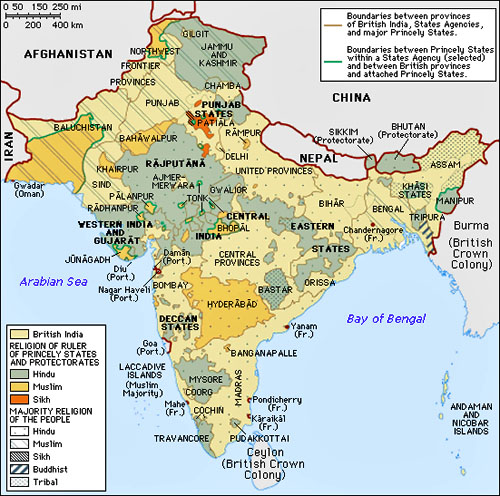
The sub-continent before 1947
In many respects there was no such thing as "India" before 1947, although the sub-continent was commonly known as "India" and commonly assumed to be under the legal control of the British Empire. The British presence there dated to the seventeenth century when the British East India Company, a quasi-private undertaking in England, received a charter to conduct (and control) operations on the sub-continent. It was only in the mid-nineteenth century that the British government assumed formal political control of the territorial and economic relationships that had been established by the East India Company. By the start of World War II, British control of India was held through a bewilderingly complicated variety of treaty relationships, as illustrated on this map.
Once the British made
the decision that something had to be done
with India after the war, the question became what exactly should be
done? Given the existing mix of princely kingdoms and differing
religions, could the entire region be established as a single,
independent political
country, as Gandhi wished? Or was there an alternative?
The key players in the decision to create India and Pakistan are briefly discussed below. Gandhi was the chief advocate of a unified India with Hindus, Muslims, Sikhs and others all living together, side-by-side, as they had for centuries, but in the end, it was decided to divide the sub-continent into two countries: Pakistan and India.

So, Why the Decision to Partition?
On 14 August 1947 and 15 August 1947, Pakistan (initially the Dominion of Pakistan then later the Islamic Republic of Pakistan) and India (initially the Union of India then later the Republic of India) became independent of the British Empire. The real "partition" was inflicted in the east where the province of Bengal was divided into the Indian state of West Bengal and the Pakistan state of East Pakistan (later independent as Bangladesh) and in the west where the Punjab region was divided into the Indian state of Punjab and the Pakistani province of Punjab.
Under the provision of the partition plan hammered out by Lord Mountbatten, the British viceroy in India, all of the princely states (and there were hundreds of them) had to decide for themselves which country to join--there were some limits on the choice. That meant a lot of jockeying for power and intrigue.
So why the decision to partition?
- The British did not want to wait; that cost money.
- Despite having been a presence in India for over two centuries, it is unclear whether the British ever really understood the complicated situation (religious, political and territorial diversity) on the sub-continent.
- Jinnah
and the Muslim League were insistent on partition (the actual
definition of that was a bit vague) and the creation of a Muslim state.
- Nehru and many Congress leaders did not want to engage in lengthy negotiations that would possibly delay the creation of India.
Immediately
upon independence, both India
and Pakistan were confronted by an unprecedented problem, a massive
population exchange, an event which many have called one of the
greatest
human migrations in recorded history. With the newly-drawn
boundaries, Muslims fled from India to Pakistan, and Hindus and Sikhs
fled from Pakistan to India. It has been estimated that
as many as fifteen million people were involved in the tragedy. The migrations
were accompanied by an unbelievable amount of disorder and also
violence, with best guess estimates ranging at anywhere up to a million
dead. Both Pakistan and India, newly-independent countries, with
as yet little in the way of effective government machinery were
completely unequipped to
deal with the chaos.
Note also that the British had taken no preventative measures to deal with any possible people fleeing from one area to the other. In fact, no large population movements were foreseen as the partition plan called for safeguards for the minorities in both countries. In any way, the outcome was a monumental disaster, an ominous sign for the start of both countries.

Some Maps
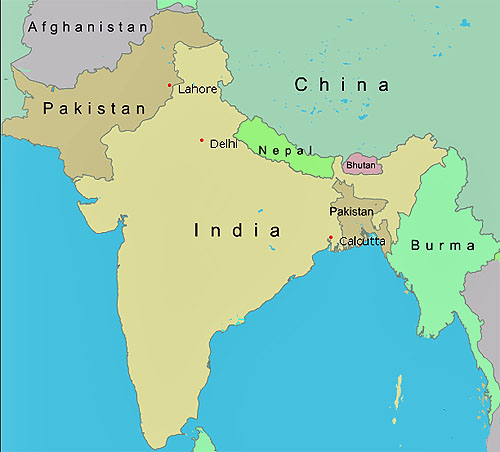
Partition Map
As can be seen from the above map, the newly created Pakistan had two parts, West Pakistan and East Pakistan, separated by a few thousand miles with India in the middle--as if that was not a recipe for disaster. An additional part of the problem was the fact that the people in East Pakistan had more in common with Bengalis in India than with Pakistanis in West Pakistan. After repeated conflict, in 1971 India supported the independence movement in East Pakistan, and Bangladesh was created as an independent country.

Pakistan

India

Gandhi
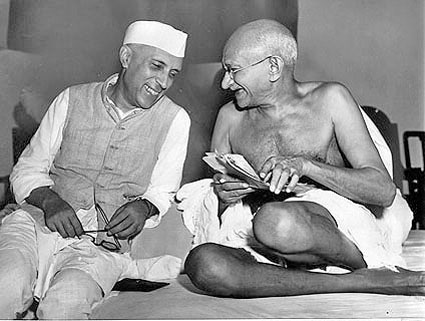
Nehru and Gandhi
I have further details about Gandhi in my HIS 135 course.
Mohandas Karamchand Gandhi (મોહનદાસ કરમચંદ ગાંધી, 2 October 1869 – 30 January 1948), aka Mahatma Gandhi (महात्मा "Great Soul") or Bapu (બાપુ "Father") was one of the world's great revolutionaries, pioneering the use of Satyagraha (mass civil disobedience) and ahimsa (complete non-violence). He led India's independence movement to its successful completion in 1947.
Gandhi steadfastly opposed any plan that partitioned India into two separate countries, but it appeared at the time that Muslims, through the voice of Jinnah, favored partition, and Congress leadership tended to view partition as the only way to avoid civil war. When confronted with this fait accompli, Gandhi reluctantly assented in the decision to go ahead with partition of the sub-continent, and he turned his attention to trying to avoid religious violence as the partition was carried out. Try as he might, Gandhi was not able to bring his dream of a single India to complete fruition.
On 30 January 1948, Gandhi was assassinated while walking on the grounds of the Birla House in New Delhi by Nathuram Godse, a Hindu radical who blamed Gandhi for the partition and for insisting on payment of a negotiated settlement with Pakistan. Gandhi's memorial (the Rāj Ghāt, New Delhi) is on the site of his cremation.

Jinnah
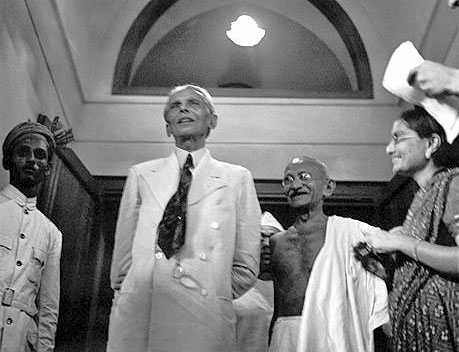
Jinnah with Gandhi
Muhammad Ali Jinnah (25 December 1876 - 11 September 1948) was one of the leaders of the All-India Muslim League and the first Governor-General of Pakistan. "He is officially known in Pakistan as Quaid-e-Azam (قائد اعظم — "Great Leader") and Baba-e-Qaum ("Father of the Nation")." After studying law in England in the 1890s, he returned to India to practice in Mumbai (Bombay).
In short order, he joined the All-India Congress (the independence movement) and then the Muslim League. After World War I, Jinnah left the Congress to focus on promoting Muslim interests, and by the 1930s he had established himself as the leading voice of the Muslim League and a consistent advocate of a separate Muslim state on the subcontinent as the only way to ensure Muslim political power. However, it was not clear until after World War II whether this new Muslim state had to be independent or could instead be part of some larger confederation.
Jinnah did not live long after the creation of Pakistan; he died of tuberculosis a little over a year after the country's independence.

Mountbatten
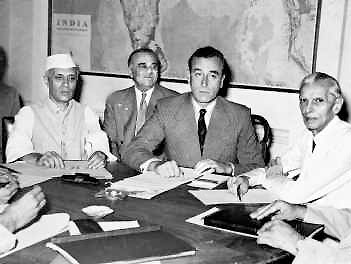
7 June 1947, Mountbatten (with Nehru to the left and Jinnah to the right;
Lord Ismay, Mountbatten's adviser behind) disclosed Britain's "partition" plan for India.
Well, British royalty can have long names, and it is no different with Lord Mountbatten. Here is the text from the wikipedia article on him:
Admiral of the Fleet Louis Francis Albert Victor Nicholas George Mountbatten, 1st Earl Mountbatten of Burma, KG, GCB, OM, GCSI, GCIE, GCVO, DSO, PC (25 June 1900–27 August 1979) was a British admiral and statesman and an uncle of Prince Philip, Duke of Edinburgh. He was the last Viceroy and first Governor-General of independent India, and First Sea Lord, as was his father, Prince Louis of Battenberg.
ps. Because of the war with Germany (World War I), the Battenberg family had changed its name to Mountbatten to appear more "English."
A long-time Royal Navy man, he served during World War I and again at the start of World War II, where he saw action in Norway and the Eastern Mediterranean.
In 1942 he was responsible for launching a series of commando raids on the French coast, including the disastrous Dieppe Raid in August 1942. About 6,000 Canadians under his command tried to capture the German-held, French port of Dieppe, with over fifty percent casualties. Despite that disaster, Mountbatten continued his climb up command ranks, and in 1943 he was appointed as head of the Southeast Asia Command (SEAC) where he supervised the liberation of Burma and Singapore.
Because of Mountbatten's Asian experience, Prime Minister Clement Attlee selected Mountbatten to be Viceroy of India in 1947 and charged him with the task of overseeing the process of creating an independent India.
In India, Mountbatten was in a difficult position. He needed to mediate between the competing claims of Jinnah (Muslim League) and Nehru (Congress) as well as meeting Gandhi's wishes. He also had to work with the hundreds of princes, each of whom headed their own individual kingdom. Mountbatten had to persuade all of them to join either Pakistan or India. That was no easy task since the princes were going to lose their head-of-state powers.
Mountbatten's task was made no easier by his personal relations with the chief protagonists. On one hand, he had very good relations with Nehru, and he was on friendly terms with Gandhi. But, on the other hand, he got on very poorly with Jinnah.
Soon after his arrival in India, Mountbatten gave up hope of a unified independent India and worked for the partition. After independence he remained in New Delhi and served as India's first governor-general.
On 27 August 1979, while sailing off the coast of Mullaghmore, County Sligo in Ireland, Mountbatten was blown to pieces by a bomb, planted in his boat by the Provisional Irish Republican Army (IRA).

Nehru
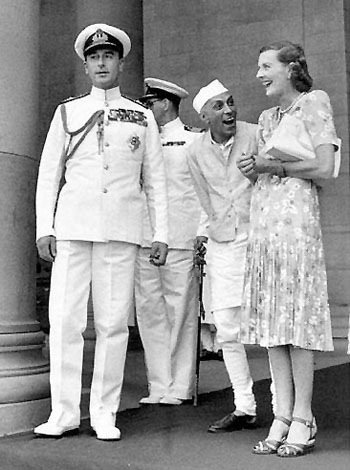
Mountbatten and Nehru
Pandit Jawaharlal Nehru (जवाहरलाल नेहर, 14 November 1889 – 27 May 1964) was a longtime leader of India's Congress Party and, along with Vallabhbhai Patel, one of Gandhi's closest collaborators.
After independence Nehru became India's first prime minister, holding that position until his death in 1964. As India's leader, he tried to steer India through a complicated international situation (the Cold War) as one of the founders of the Non-Aligned Movement of countries that asserted their neutrality between the US and USSR. Nehru hoped to act as an intermediary between the communist states and the Western bloc.

Web pages within the course relevant to the Division of South Asia

Some suggestions for further research
Two good timelines of events in India are Timeline: 1885-1947 and Timeline of Indian Independence. There are many available online.
The wikipedia article on the Partition of India is well done.
See the India Memory Project for recollections about the partition experience.
Freedom at Midnight (1975) by Dominique Lapierre and Larry Collins is an excellent (and readable) account of the events leading to the partition and Gandhi's assassination.
Gandhi (1982), directed by Richard Attenborough, starring Ben Kingsley as Gandhi. The movie won eight Academy Awards.
See the essay by Salman Rushdie at The Time 100 (The Most important People of the Century): Mohandas Gandhi. The site has the famous picture of Gandhi at his spinning and also has images of the different covers of Time magazine on which Gandhi appeared.